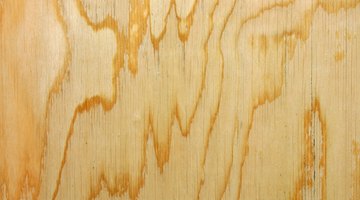Repairing Delaminated Plywood Using Epoxy
Plywood installed in moist areas may occasionally suffer from delamination. Delamination occurs when the adhesive of a plywood veneer fails and the top layer separates from the rest of the plywood. You can repair sound, dry plywood suffering from delamination using an epoxy resin.

If the moisture damage extends to the fibers beneath the plywood's veneer, though, you can't save the plywood. Plywood with extensive moisture damage must be cut out and replaced with sound plywood.
Things You Will Need
- Utility knife
- Coarse-grit sandpaper
- Brush
- Painter's tape
- Epoxy resin
- Trowel
- Container
- Graduated syringe
- Wood screws
- Noncorrosive galvanized staples
- Staple gun
- Plastic sheeting
- Plywood
- Weight
Tip
Open all of the windows and doors in your work area to ensure adequate ventilation.
-
Cut the delaminated plywood veneer face away with a utility knife.
-
Examine the exposed plywood. If the plywood is dry and otherwise sound, move on to Step 3. If the fibers are swollen and warped, indicating water damage, do not proceed with an epoxy fix. You'll have to remove and replace the plywood panel.
-
Sand the exposed section of plywood and the underside of the removed piece of veneer lightly with coarse-grit sandpaper. Sand just enough to roughen the surface and remove any loose wood fibers and existing adhesive. Sweep away all of the sanding dust so that the work area is clean and free of loose debris.
-
Protect the adjacent surfaces from the epoxy. Place a wide strip of painter's tape around all sides of the exposed area.
-
Mix the epoxy hardener with the epoxy resin according to the manufacturer's instructions. Measure precisely, using the graduated syringes provided with the epoxy. Mix just enough to cover the repair job. Stir the epoxy continuously for 90 seconds before moving on to Step 6.
-
Apply a thin layer of epoxy resin to the exposed plywood with a trowel. Make the layer slightly higher than the surrounding wood. The layer must not be thick enough to spill over onto the adjacent tape.
-
Leave the epoxy to set for five to 10 minutes or the amount of time the label recommends waiting before placing objects on the surface of the epoxy resin.
-
Replace the laminate surface. Press it down to ensure contact. Take care not to move the laminate sheet out of place as you press.
-
Install noncorrosive wood screws at each corner of the repair. Secure repairs smaller than 6 square inches with noncorrosive galvanized staples.
-
Weigh the repair down: First place a sheet of plastic over the repair area. Then place a sheet of plywood -- cut at least 6 inches wider than the repair on all sides -- over the plastic. Place bricks, concrete blocks or other items over the repair. Keep them in place for the duration of the cure time recommended for the epoxy resin.
-
Lift the weights and remove the masking tape after the cure time has elapsed.
-
Sand down any epoxy resin residue with coarse sandpaper.
The Drip Cap
- Plywood installed in moist areas may occasionally suffer from delamination.
- Plywood with extensive moisture damage must be cut out and replaced with sound plywood.
- Examine the exposed plywood.
- Sand just enough to roughen the surface and remove any loose wood fibers and existing adhesive.
- Leave the epoxy to set for five to 10 minutes or the amount of time the label recommends waiting before placing objects on the surface of the epoxy resin.
- Install noncorrosive wood screws at each corner of the repair.
- Then place a sheet of plywood -- cut at least 6 inches wider than the repair on all sides -- over the plastic.
Writer Bio
Based in Houston, Texas, Meg Butler is a professional farmer, house flipper and landscaper. When not busy learning about homes and appliances she's sharing that knowledge. Butler began blogging, editing and writing in 2000. Her work has appered in the "Houston Press" and several other publications. She has an A.A. in journalism and a B.A. in history from New York University.
Photo Credits
- Hemera Technologies/AbleStock.com/Getty Images
- Hemera Technologies/AbleStock.com/Getty Images
More Articles



